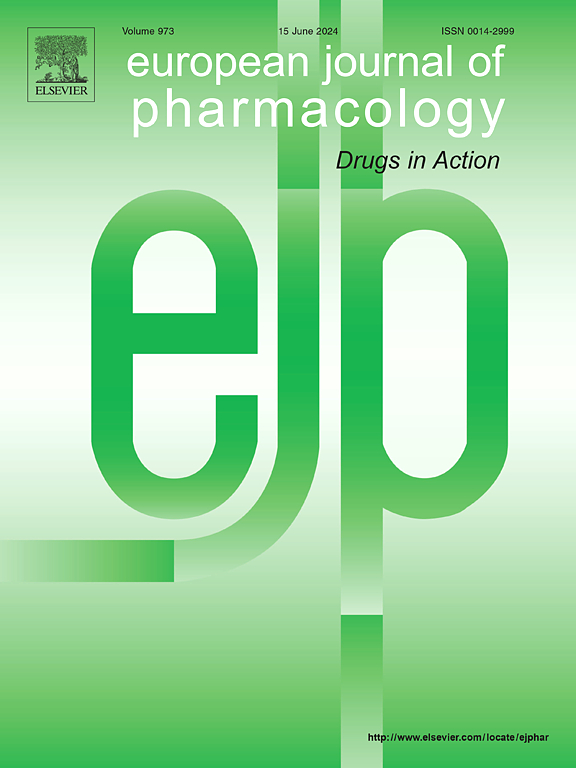N-(4-methoxyphenyl) quinoline-8-sulfonamide reduces the inflammatory response of fibroblast-like synoviocytes by targeting receptor (calcitonin) activity modifying protein 1 in rheumatoid arthritis
IF 4.7
3区 医学
Q1 PHARMACOLOGY & PHARMACY
引用次数: 0
Abstract
Background
Rheumatoid arthritis (RA) is characterized by chronic inflammation of the synovium of joints. Fibroblast-like synoviocytes (FLS) play an important role in RA pathogenesis. We aimed to investigate the effect of N-(4-methoxyphenyl) quinoline-8-sulfonamide (QS-3g) on the inflammatory response of FLS and explore the potential underlying mechanisms.
Methods
We screened and found that QS-3g exhibits the best anti-inflammatory response against FLS using the CCK8 assay. To investigate the therapeutic effects of QS-3g on K/BxN STA mice, we used H&E staining, immunofluorescence, immunohistochemistry, micro-CT, and other techniques. Additional investigations, including RNA-seq, molecular docking, and CETSA, revealed that QS-3g binds to RAMP1.
Results
Among a series of 8-quinoline sulfonyl amide derivatives, QS-3g reduced the inflammatory response in TNF-α stimulated FLS, such as the release of interleukin (IL)-1β and IL-6. H&E staining and micro-CT showed that QS-3g inhibited synovial hypertrophy, inflammatory cell infiltration, and bone destruction. RNA-seq and CETSA analyses revealed the targeted inhibition of RAMP1 by QS-3g. Inhibition of RAMP1 expression could reduce IL-6 and IL-1β levels. Compared with RAMP1-si, combined administration of QS-3g and RAMP1-si reduced the TNF-α-induced inflammation in TNF-α stimulated FLS without statistically significant differences. Finally, the results of in vitro experiments showed that QS-3g could restore the balance of Gαi/Gαs by inhibiting Gαi and activating Gαs and up-regulate the expression of cAMP protein, thus inhibiting the RAMP1-mediated inflammatory response in FLS.
Conclusion
QS-3g could inhibit RAMP1 activity and mediate the Gαs/Gαi–cAMP pathway to reduce FLS inflammatory response. Therefore, QS-3g may serve as a novel anti-inflammatory compound for treating RA.
N-(4-甲氧基苯基)喹啉-8-磺酰胺通过靶向受体(降钙素)活性修饰蛋白 1 减轻类风湿性关节炎成纤维细胞样滑膜细胞的炎症反应。
背景:类风湿性关节炎(RA类风湿性关节炎(RA)的特征是关节滑膜的慢性炎症。成纤维细胞样滑膜细胞(FLS)在 RA 的发病机制中发挥着重要作用。我们旨在研究N-(4-甲氧基苯基)喹啉-8-磺酰胺(QS-3g)对FLS炎症反应的影响,并探索其潜在的内在机制:我们利用 CCK8 试验筛选并发现 QS-3g 对 FLS 的抗炎反应最佳。为了研究 QS-3g 对 K/BxN STA 小鼠的治疗效果,我们使用了 H&E 染色、免疫荧光、免疫组化、显微 CT 等技术。包括RNA-seq、分子对接和CETSA在内的其他研究发现,QS-3g与RAMP1结合:结果:在一系列 8-喹啉磺酰胺衍生物中,QS-3g 可降低 TNF-α 刺激的 FLS 的炎症反应,如白细胞介素(IL)-1β 和 IL-6 的释放。H&E 染色和显微 CT 显示,QS-3g 可抑制滑膜肥厚、炎症细胞浸润和骨质破坏。RNA-seq 和 CETSA 分析显示,QS-3g 对 RAMP1 有靶向抑制作用。抑制 RAMP1 的表达可降低 IL-6 和 IL-1β 的水平。与RAMP1-si相比,联合使用QS-3g和RAMP1-si可减少TNF-α刺激FLS诱发的炎症,但差异无统计学意义。最后,体外实验结果表明,QS-3g可通过抑制Gαi和激活Gαs来恢复Gαi/Gαs的平衡,并上调cAMP蛋白的表达,从而抑制RAMP1介导的FLS炎症反应:结论:QS-3g 可抑制 RAMP1 的活性,介导 Gαs/Gαi-cAMP 通路,从而减轻 FLS 的炎症反应。因此,QS-3g 可作为治疗 RA 的新型抗炎化合物。
本文章由计算机程序翻译,如有差异,请以英文原文为准。
求助全文
约1分钟内获得全文
求助全文
来源期刊
CiteScore
9.00
自引率
0.00%
发文量
572
审稿时长
34 days
期刊介绍:
The European Journal of Pharmacology publishes research papers covering all aspects of experimental pharmacology with focus on the mechanism of action of structurally identified compounds affecting biological systems.
The scope includes:
Behavioural pharmacology
Neuropharmacology and analgesia
Cardiovascular pharmacology
Pulmonary, gastrointestinal and urogenital pharmacology
Endocrine pharmacology
Immunopharmacology and inflammation
Molecular and cellular pharmacology
Regenerative pharmacology
Biologicals and biotherapeutics
Translational pharmacology
Nutriceutical pharmacology.

 求助内容:
求助内容: 应助结果提醒方式:
应助结果提醒方式:


